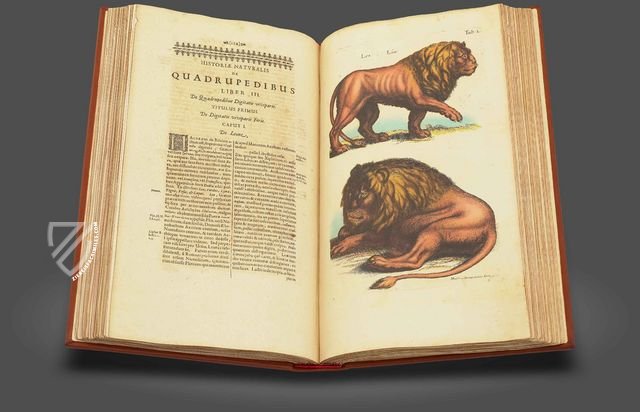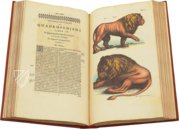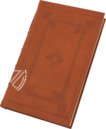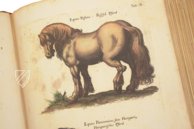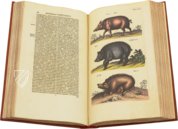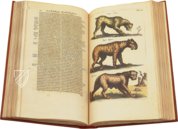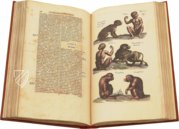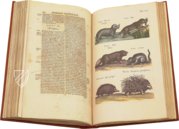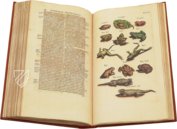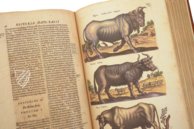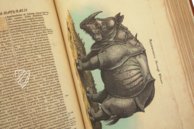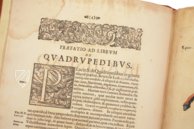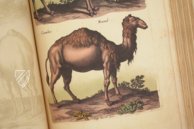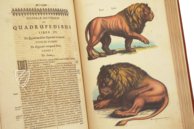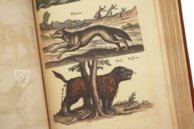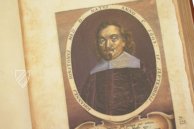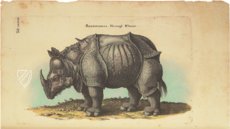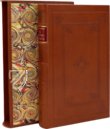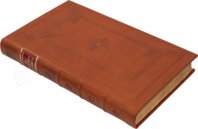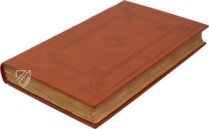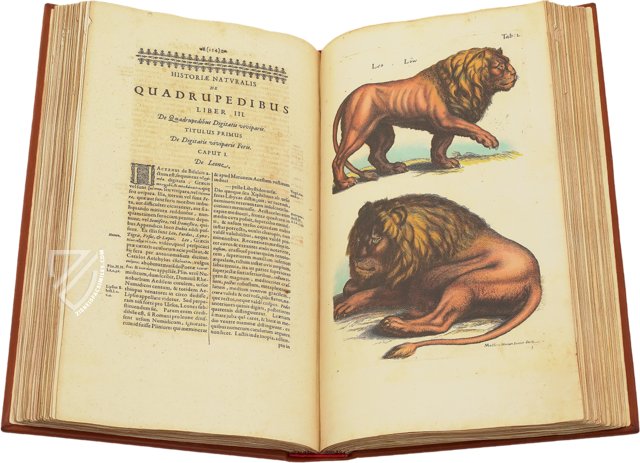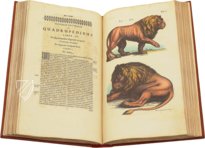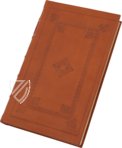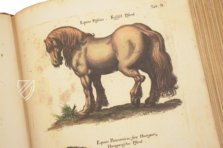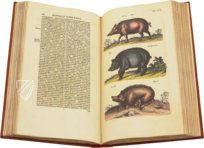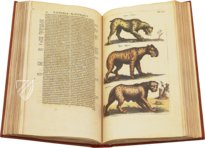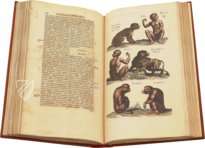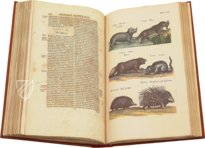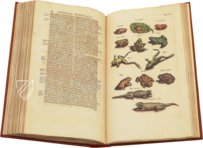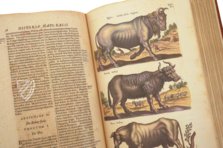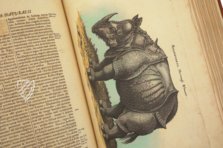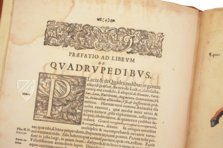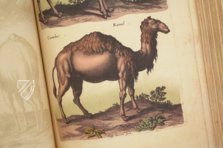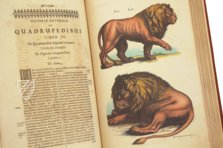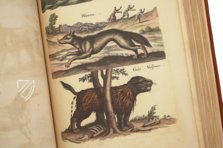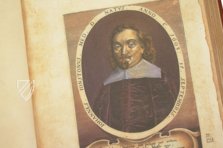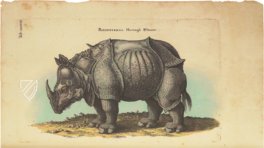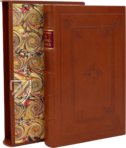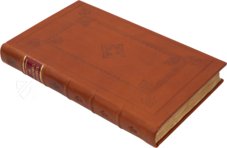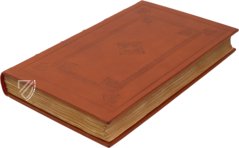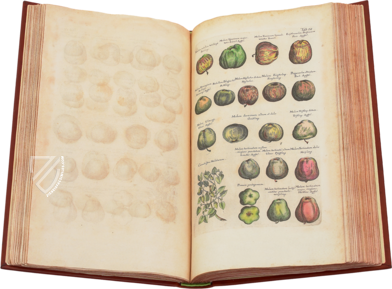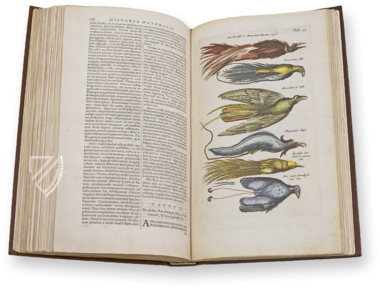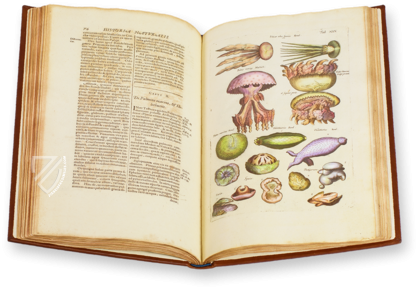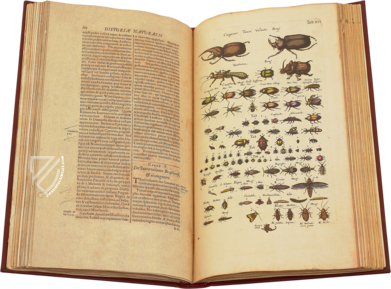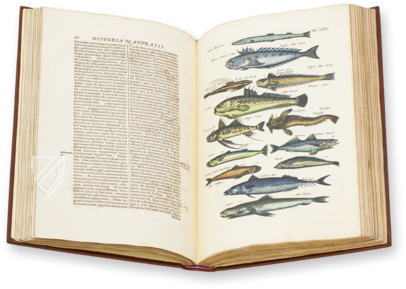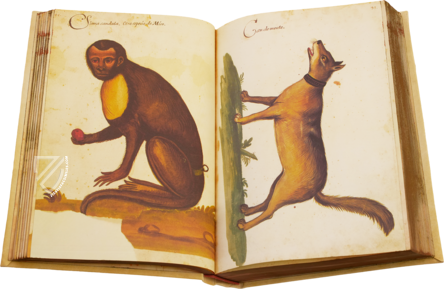Historia Naturalis: De Quadrupedibus
(3,000€ - 7,000€)
Whether dog, ape, or crocodile, all kinds of animals on four legs are assembled in the second volume of the famous Historia Naturalis by John Jonston about quadrupeds. The animals are classified and explained scientifically in the text and are visualized for the beholder with gorgeous, colored illustrations. The Polish doctor and Renaissance man John Jonston wrote an encyclopedic overview of the history of animals in five volumes with the title Historia Naturalis around the mid–17th century. The standard work of 17th century zoology appeared between 1650 and 1653 in the publishing house of Matthäus Merian the Younger in Frankfurt am Main. This “most broadly disseminated zoological handbook” experienced numerous republications and translations into other languages, still offering a magnificent and often curious glimpse into the world of zoology today.
Historia Naturalis: De Quadrupedibus
Whether dog, ape, or crocodile, all kinds of animals on four legs are assembled in the second volume of the famous Historia Naturalis by John Jonston about quadrupeds. The animals are classified and explained scientifically in the text and are visualized for the beholder with gorgeous, colored illustrations. The Polish doctor and Renaissance man John Jonston wrote an encyclopedic overview of the history of animals in five volumes with the title Historia Naturalis around the mid–17th century. The standard work of 17th century zoology appeared between 1650 and 1653 in the publishing house of Matthäus Merian the Younger in Frankfurt am Main. This “most broadly disseminated zoological handbook” experienced numerous republications and translations into other languages, still offering a magnificent and often curious glimpse into the world of zoology today.
The Renaissance Man John Jonston
John Jonston (1603–1675) was the son of Scottish parents, a doctor, and a Renaissance man from Poland. He was famous through his numerous writings and pedagogical purposes concerning such diverse topics as child-rearing, philosophy and theology, history, but also medicine and mineralogy. Jonston’s aim was to convey and pass on the collected knowledge of his time. He pursued this goal among others, including as a tutor and tour guide of young noblemen. He himself acquired his comprehensive knowledge while on un study tours and stays across Europe. John Jonston is still known today – especially to biologists and zoologists – for his magnum opus, the famous five-volume Historia Naturalis Animalium.
All Animals on Four Legs
The second band of the encyclopedic series under the title Historia Naturalis de Quadrupedibus is dedicated to quadrupeds. Johnson subdivided the animals in individual chapters, among others as equines, cloven hoofed animals, house pets, etc. Every possible animal is thoroughly described and illustrated in copperplate engravings in the work. The reader is informed about horses, elephants and camels, cattle, sheep, wild game, dogs and wolves, trained bears, apes, anteaters, rodents, but also reptiles such as crocodiles, chameleons, or tortoises. As a result, the classification does not always follow modern principles, but in this way it gives a magnificent glimpse in the zoological science of the 17th century. A curious anecdote concerns the template of Albrecht Dürer’s famous woodcut of a rhinoceros from the year 1515 used for the illustration of the animal. Nearly 150 years after its creation, the woodcut of the great master of the German Renaissance is still relevant!
Standard Work of Zoology
The Historia Naturalis de Quadrupedibus is only one of five volumes of the encyclopedic zoology of John Jonston. For his incomplete magnum opus, Jonston planned a comprehensive illustrated depiction of the world of animals, plants, and people. The Historia Naturalis Animalium was printed from 1650 to 1653 in the publishing house of Matthäus Merian the Younger in Frankfurt am Main. Merian (1621–1687), who took over the famous atelier of his father Matthäus Merian the Elder, as copperplate engraver was also responsible for the artistic design of the editions. The high-quality illustrations, colorfully illustrated moreover, lend the sophisticated publication its final touches and are surely a reason for the exceptional popularity of the Historia Naturalis across Europe.
Codicology
- Size / Format
- 400 pages / 38.0 × 22.0 cm
- Origin
- Germany
- Date
- 1652
- Epochs
- Style
- Language
- Illustrations
- 80 copperplate engravings depicting more than 350 animals
- Artist / School
- Johannes Jonstonus (John Jonston) (1603–1675) (author)
Matthaeus Merian The Younger (1621–1687) (engraver)
Historia Naturalis: De Quadrupedibus
Dogs
The genus Canis includes wolves, coyotes, golden jackals and domesticated dogs such as these two fine specimens. Standing in the foreground is a muscular short-haired mastiff-type breed, which has been used for hunting, in war, and as a guard dog in Europe and Asia for 3,000 years. The long-haired dog sitting behind it resembles an Irish Wolfhound, which hunts primarily through sight and speed rather than scent and was first referred to by the Roman Consul Quintus Aurelius Symmachus in AD 391.
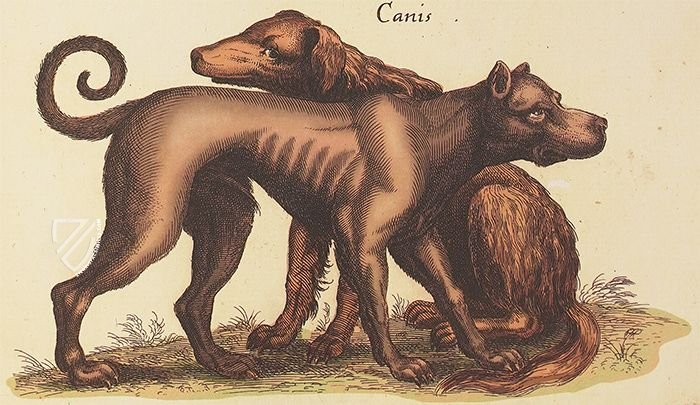
Historia Naturalis: De Quadrupedibus
Dürer's Rhinoceros
An Indian rhinoceros arrived in Lisbon to great fanfare on May 20th, 1515. It was the first living example of the species to be seen in Europe since the Roman Empire and was studied and sketched by various scholars and artists. Albrecht Dürer created a famous woodcut of the animal that had become something of a mythical beast in Europe, but which in the context of the Renaissance was treated like a rediscovered piece of antiquity.
Nearly 150 years after it was first executed by Dürer, this woodcut of a rhinoceros was included in the codex by Matthaeus Merian the Younger, the engraver responsible for it, because of both its artistry and its accuracy. Although impossibly strong and powerful, the rhinoceros appears calm, almost serene.
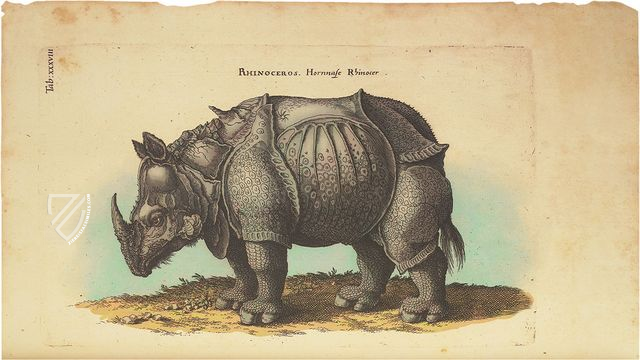
#1 Historia Naturalis: De Quadrupedibus
Language: Spanish
(3,000€ - 7,000€)
- Treatises / Secular Books
- Apocalypses / Beatus
- Astronomy / Astrology
- Bestiaries
- Bibles / Gospels
- Chronicles / History / Law
- Geography / Maps
- Saints' Lives
- Islam / Oriental
- Judaism / Hebrew
- Single Leaf Collections
- Leonardo da Vinci
- Literature / Poetry
- Liturgical Manuscripts
- Medicine / Botany / Alchemy
- Music
- Mythology / Prophecies
- Psalters
- Other Religious Books
- Games / Hunting
- Private Devotion Books
- Other Genres
- Afghanistan
- Armenia
- Austria
- Belgium
- Belize
- Bosnia and Herzegovina
- China
- Colombia
- Costa Rica
- Croatia
- Cyprus
- Czech Republic
- Denmark
- Egypt
- El Salvador
- Ethiopia
- France
- Germany
- Greece
- Guatemala
- Honduras
- Hungary
- India
- Iran
- Iraq
- Israel
- Italy
- Japan
- Jordan
- Kazakhstan
- Kyrgyzstan
- Lebanon
- Liechtenstein
- Luxembourg
- Mexico
- Morocco
- Netherlands
- Palestine
- Panama
- Peru
- Poland
- Portugal
- Romania
- Russia
- Serbia
- Spain
- Sri Lanka
- Sweden
- Switzerland
- Syria
- Tajikistan
- Turkey
- Turkmenistan
- Ukraine
- United Kingdom
- United States
- Uzbekistan
- Vatican City
- A. Oosthoek, van Holkema & Warendorf
- Aboca Museum
- Ajuntament de Valencia
- Akademie Verlag
- Akademische Druck- u. Verlagsanstalt (ADEVA)
- Aldo Ausilio Editore - Bottega d’Erasmo
- Alecto Historical Editions
- Alkuin Verlag
- Almqvist & Wiksell
- Amilcare Pizzi
- Andreas & Andreas Verlagsbuchhandlung
- Archa 90
- Archiv Verlag
- Archivi Edizioni
- Arnold Verlag
- ARS
- Ars Magna
- ArtCodex
- AyN Ediciones
- Azimuth Editions
- Badenia Verlag
- Bärenreiter-Verlag
- Belser Verlag
- Belser Verlag / WK Wertkontor
- Benziger Verlag
- Bernardinum Wydawnictwo
- BiblioGemma
- Biblioteca Apostolica Vaticana (Vaticanstadt, Vaticanstadt)
- Bibliotheca Palatina Faksimile Verlag
- Bibliotheca Rara
- Boydell & Brewer
- Bramante Edizioni
- Bredius Genootschap
- Brepols Publishers
- British Library
- C. Weckesser
- Caixa Catalunya
- Canesi
- CAPSA, Ars Scriptoria
- Caratzas Brothers, Publishers
- Carus Verlag
- Casamassima Libri
- Centrum Cartographie Verlag GmbH
- Chavane Verlag
- Christian Brandstätter Verlag
- Circulo Cientifico
- Club Bibliófilo Versol
- Club du Livre
- CM Editores
- Collegium Graphicum
- Collezione Apocrifa Da Vinci
- Comissão Nacional para as Comemorações dos Descobrimentos Portugueses
- Coron Verlag
- Corvina
- CTHS
- D. S. Brewer
- Damon
- De Agostini/UTET
- De Nederlandsche Boekhandel
- De Schutter
- Deuschle & Stemmle
- Deutscher Verlag für Kunstwissenschaft
- DIAMM
- Droz
- E. Schreiber Graphische Kunstanstalten
- Ediciones Boreal
- Ediciones Grial
- Ediclube
- Edições Inapa
- Edilan
- Editalia
- Edition Deuschle
- Edition Georg Popp
- Edition Leipzig
- Edition Libri Illustri
- Editiones Reales Sitios S. L.
- Éditions de l'Oiseau Lyre
- Editions Medicina Rara
- Editorial Casariego
- Editorial Mintzoa
- Editrice Antenore
- Editrice Velar
- Edizioni Edison
- Egeria, S.L.
- Eikon Editores
- Electa
- Emery Walker Limited
- Enciclopèdia Catalana
- Eos-Verlag
- Ephesus Publishing
- Ernst Battenberg
- Eugrammia Press
- Extraordinary Editions
- Fackelverlag
- Facsimila Art & Edition
- Facsimile Editions Ltd.
- Facsimilia Art & Edition Ebert KG
- Faksimile Verlag
- Feuermann Verlag
- Folger Shakespeare Library
- Franco Cosimo Panini Editore
- Friedrich Wittig Verlag
- Fundación Hullera Vasco-Leonesa
- G. Braziller
- Gabriele Mazzotta Editore
- Gebr. Mann Verlag
- Gesellschaft für graphische Industrie
- Getty Research Institute
- Giovanni Domenico de Rossi
- Giunti Editore
- Graffiti
- Grafica European Center of Fine Arts
- Guido Pressler
- Guillermo Blazquez
- Gustav Kiepenheuer
- H. N. Abrams
- Harrassowitz
- Harvard University Press
- Helikon
- Hendrickson Publishers
- Henning Oppermann
- Herder Verlag
- Hes & De Graaf Publishers
- Hoepli
- Holbein-Verlag
- Houghton Library
- Hugo Schmidt Verlag
- Idion Verlag
- Il Bulino, edizioni d'arte
- ILte
- Imago
- Insel Verlag
- Insel-Verlag Anton Kippenberger
- Instituto de Estudios Altoaragoneses
- Instituto Nacional de Antropología e Historia
- Introligatornia Budnik Jerzy
- Istituto dell'Enciclopedia Italiana - Treccani
- Istituto Ellenico di Studi Bizantini e Postbizantini
- Istituto Geografico De Agostini
- Istituto Poligrafico e Zecca dello Stato
- Italarte Art Establishments
- Jan Thorbecke Verlag
- Johnson Reprint Corporation
- Josef Stocker
- Josef Stocker-Schmid
- Jugoslavija
- Karl W. Hiersemann
- Kasper Straube
- Kaydeda Ediciones
- Kindler Verlag / Coron Verlag
- Kodansha International Ltd.
- Konrad Kölbl Verlag
- Kurt Wolff Verlag
- La Liberia dello Stato
- La Linea Editrice
- La Meta Editore
- Lambert Schneider
- Landeskreditbank Baden-Württemberg
- Leo S. Olschki
- Les Incunables
- Liber Artis
- Library of Congress
- Libreria Musicale Italiana
- Lichtdruck
- Lito Immagine Editore
- Lumen Artis
- Lund Humphries
- M. Moleiro Editor
- Maison des Sciences de l'homme et de la société de Poitiers
- Manuscriptum
- Martinus Nijhoff
- Maruzen-Yushodo Co. Ltd.
- MASA
- Massada Publishers
- McGraw-Hill
- Metropolitan Museum of Art
- Militos
- Millennium Liber
- Müller & Schindler
- Nahar - Stavit
- Nahar and Steimatzky
- National Library of Wales
- Neri Pozza
- Nova Charta
- Oceanum Verlag
- Odeon
- Orbis Mediaevalis
- Orbis Pictus
- Österreichische Staatsdruckerei
- Oxford University Press
- Pageant Books
- Parzellers Buchverlag
- Patrimonio Ediciones
- Pattloch Verlag
- PIAF
- Pieper Verlag
- Plon-Nourrit et cie
- Poligrafiche Bolis
- Presses Universitaires de Strasbourg
- Prestel Verlag
- Princeton University Press
- Prisma Verlag
- Priuli & Verlucca, editori
- Pro Sport Verlag
- Propyläen Verlag
- Pytheas Books
- Quaternio Verlag Luzern
- Reales Sitios
- Recht-Verlag
- Reichert Verlag
- Reichsdruckerei
- Reprint Verlag
- Riehn & Reusch
- Roberto Vattori Editore
- Rosenkilde and Bagger
- Roxburghe Club
- Salerno Editrice
- Saltellus Press
- Sandoz
- Sarajevo Svjetlost
- Schöck ArtPrint Kft.
- Schulsinger Brothers
- Scolar Press
- Scrinium
- Scripta Maneant
- Scriptorium
- Shazar
- Siloé, arte y bibliofilia
- SISMEL - Edizioni del Galluzzo
- Sociedad Mexicana de Antropología
- Société des Bibliophiles & Iconophiles de Belgique
- Soncin Publishing
- Sorli Ediciones
- Stainer and Bell
- Studer
- Styria Verlag
- Sumptibus Pragopress
- Szegedi Tudomànyegyetem
- Taberna Libraria
- Tarshish Books
- Taschen
- Tempus Libri
- Testimonio Compañía Editorial
- Thames and Hudson
- The Clear Vue Publishing Partnership Limited
- The Facsimile Codex
- The Folio Society
- The Marquess of Normanby
- The Richard III and Yorkist History Trust
- Tip.Le.Co
- TouchArt
- TREC Publishing House
- TRI Publishing Co.
- Trident Editore
- Tuliba Collection
- Typis Regiae Officinae Polygraphicae
- Union Verlag Berlin
- Universidad de Granada
- University of California Press
- University of Chicago Press
- Urs Graf
- Vallecchi
- Van Wijnen
- VCH, Acta Humaniora
- VDI Verlag
- VEB Deutscher Verlag für Musik
- Verlag Anton Pustet / Andreas Verlag
- Verlag Bibliophile Drucke Josef Stocker
- Verlag der Münchner Drucke
- Verlag für Regionalgeschichte
- Verlag Styria
- Vicent Garcia Editores
- W. Turnowski Ltd.
- W. Turnowsky
- Waanders Printers
- Wiener Mechitharisten-Congregation (Wien, Österreich)
- Wissenschaftliche Buchgesellschaft
- Wissenschaftliche Verlagsgesellschaft
- Wydawnictwo Dolnoslaskie
- Xuntanza Editorial
- Zakład Narodowy
- Zollikofer AG

